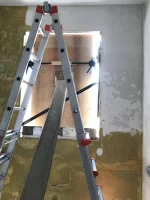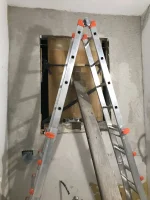Go easy as I am new to this, please! I live on one of the smaller Canary Islands and the normally hot but windy desert island climate has suddenly hit a 26*c but 60% humid windless week and my plaster is drying slow.
There are big problems getting materials here at the moment so please don’t criticise the materials I am using, too much! I paid a professional to do my other room, and he ended up using plasterboard adhesive mix as the bonding layer because there no other gypsum plaster to do the job.
I have prepped my kitchen wall with non tacky yellow bonding agent, which is basically blue grit.
On a smalI section there was horrible old cracked concrete so I then laid on a 3mmish layer of 90% pure finishing grade plaster (expensive) on that part and embedded mesh (the only type for sale at the moment), that plaster is still grey. I also prepped that grey area with pva, worried about the strong wind tunnel I have due to no windows, so it is well sealed tacky bluegrit. When I was laying it on I moved out of the pva areas where you can see there is white dry plaster (bottom right & top left)
So I did all this 44hours ago and, I was too scared to key it because there is mesh, I had no time to put my next two layers on the wall whilst it was wet as it hung forever because with no wind, mesh embedded and the wall well sealed there was no sucking the moisture out of it and that meant it didn’t go off even after over 4 hours.
my question is can I pva it and go on with my next two coats now?
Or I was thinking maybe I would do a separate mix for that section with pva mixed in the plaster and forget pva directly on the wall?
There are big problems getting materials here at the moment so please don’t criticise the materials I am using, too much! I paid a professional to do my other room, and he ended up using plasterboard adhesive mix as the bonding layer because there no other gypsum plaster to do the job.
I have prepped my kitchen wall with non tacky yellow bonding agent, which is basically blue grit.
On a smalI section there was horrible old cracked concrete so I then laid on a 3mmish layer of 90% pure finishing grade plaster (expensive) on that part and embedded mesh (the only type for sale at the moment), that plaster is still grey. I also prepped that grey area with pva, worried about the strong wind tunnel I have due to no windows, so it is well sealed tacky bluegrit. When I was laying it on I moved out of the pva areas where you can see there is white dry plaster (bottom right & top left)
So I did all this 44hours ago and, I was too scared to key it because there is mesh, I had no time to put my next two layers on the wall whilst it was wet as it hung forever because with no wind, mesh embedded and the wall well sealed there was no sucking the moisture out of it and that meant it didn’t go off even after over 4 hours.
my question is can I pva it and go on with my next two coats now?
Or I was thinking maybe I would do a separate mix for that section with pva mixed in the plaster and forget pva directly on the wall?
Attachments
Last edited:


